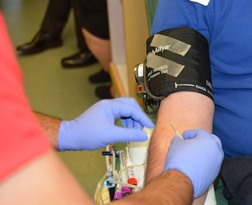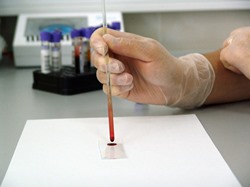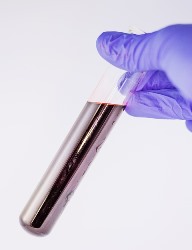Selecting a Phlebotomy Course near Radium Springs New Mexico
 Enrolling in the right phlebotomy training near Radium Springs NM is a critical first step toward a gratifying profession as a phlebotomist. It might seem like a difficult task to assess and compare each of the school alternatives that are accessible to you. Nevertheless it’s important that you perform your due diligence to make sure that you receive a superior education. In reality, many potential students begin the process by considering two of the qualifiers that first come to mind, which are location and cost. Another option you may look into is whether to attend online classes or commute to a nearby campus. We’ll review more about online schools later in this article. What’s important to remember is that there is much more to checking out phlebotomy training programs than locating the cheapest or the closest one. Other variables including reputation and accreditation are also important considerations and must be part of your decision process also. To assist in that effort, we will furnish a list of questions that you should ask each of the phlebotomy schools you are assessing to help you choose the best one for you. But prior to doing that, let’s address what a phlebotomist is and does, and afterwards resume our discussion about online training.
Enrolling in the right phlebotomy training near Radium Springs NM is a critical first step toward a gratifying profession as a phlebotomist. It might seem like a difficult task to assess and compare each of the school alternatives that are accessible to you. Nevertheless it’s important that you perform your due diligence to make sure that you receive a superior education. In reality, many potential students begin the process by considering two of the qualifiers that first come to mind, which are location and cost. Another option you may look into is whether to attend online classes or commute to a nearby campus. We’ll review more about online schools later in this article. What’s important to remember is that there is much more to checking out phlebotomy training programs than locating the cheapest or the closest one. Other variables including reputation and accreditation are also important considerations and must be part of your decision process also. To assist in that effort, we will furnish a list of questions that you should ask each of the phlebotomy schools you are assessing to help you choose the best one for you. But prior to doing that, let’s address what a phlebotomist is and does, and afterwards resume our discussion about online training.
[campusexplorer header_text=”Find Phlebotomy Schools Near You!” aos=”75346615″ concentration=”E7147EE5″ tracking=”PHL-CT”]
Phlebotomy Technician Job Summary
 A phlebotomist, or phlebotomy technician, collects blood samples from patients. Although that is their primary duty, there is in fact far more to their job description. Before drawing a blood sample, a phlebotomist needs to confirm that the tools being employed are single use only and sterile. Following the collection, the sample must be correctly labeled with the patient’s data. Next, paperwork has to be correctly completed in order to track the sample from the time of collection through the laboratory testing process. The phlebotomist then delivers the blood to either an in-house lab or to an outside lab facility where it can be tested for such things as infectious diseases, pregnancy or blood type. A number of Radium Springs NM phlebotomists in fact work in labs and are accountable for ensuring that samples are analyzed properly under the highest quality control procedures. And if those weren’t sufficient duties, they may be required to instruct other phlebotomists in the drawing, transport and follow-up process.
A phlebotomist, or phlebotomy technician, collects blood samples from patients. Although that is their primary duty, there is in fact far more to their job description. Before drawing a blood sample, a phlebotomist needs to confirm that the tools being employed are single use only and sterile. Following the collection, the sample must be correctly labeled with the patient’s data. Next, paperwork has to be correctly completed in order to track the sample from the time of collection through the laboratory testing process. The phlebotomist then delivers the blood to either an in-house lab or to an outside lab facility where it can be tested for such things as infectious diseases, pregnancy or blood type. A number of Radium Springs NM phlebotomists in fact work in labs and are accountable for ensuring that samples are analyzed properly under the highest quality control procedures. And if those weren’t sufficient duties, they may be required to instruct other phlebotomists in the drawing, transport and follow-up process.
Where do Phlebotomists Practice?
The most basic answer is wherever they treat patients. Their work places are many and varied, including Radium Springs NM medical clinics, hospitals, long-term care facilities, or blood banks. They may be assigned to collect blood samples from patients of of every age, from babies or young children to seniors. A number of phlebotomists, based on their practice and their training, specialize in collecting samples from a specific kind of patient. For instance, those working in a nursing home or assisted living facility would only be collecting blood from elderly patients. If they are practicing in a maternity ward, they would be drawing blood from mothers and newborns solely. On the other hand, phlebotomy technicians practicing in a general hospital environment would be collecting samples from a wide variety of patients and would collect samples from new patients every day.
Phlebotomist Training, Certification and Licensing
 There are basically two kinds of programs that provide phlebotomist training in Radium Springs NM, which are certificate and degree programs. The certificate program normally takes under a year to finish and provides a general education as well as the training on how to draw blood. It provides the quickest means to becoming a phlebotomist. An Associate of Science Degree in Clinical Laboratory Science, although not exclusively a phlebotomist degree, will provide training on becoming a phlebotomy tech. Offered at community and junior colleges, they normally require two years to finish. Bachelor’s Degrees are less available and as a 4 year program furnish a more comprehensive background in lab sciences. Once you have completed your training, you will no doubt want to become certified. While not required in most states, many employers look for certification before hiring technicians. A few of the key certifying agencies include:
There are basically two kinds of programs that provide phlebotomist training in Radium Springs NM, which are certificate and degree programs. The certificate program normally takes under a year to finish and provides a general education as well as the training on how to draw blood. It provides the quickest means to becoming a phlebotomist. An Associate of Science Degree in Clinical Laboratory Science, although not exclusively a phlebotomist degree, will provide training on becoming a phlebotomy tech. Offered at community and junior colleges, they normally require two years to finish. Bachelor’s Degrees are less available and as a 4 year program furnish a more comprehensive background in lab sciences. Once you have completed your training, you will no doubt want to become certified. While not required in most states, many employers look for certification before hiring technicians. A few of the key certifying agencies include:
- National Phlebotomy Association
- National Healthcareer Association (NHA)
- American Society for Clinical Pathology (ASCP)
- American Medical Technologists (AMT)
There are some states that do call for certification in order to practice as a phlebotomist, like California and Nevada. California and a few additional states even require licensing. So it’s essential that you select a phlebotomist training program that not only provides a quality education, but also preps you for any certification or licensing exams that you are required or elect to take.
Online Phlebotomist Certificates and Degrees
 First, let’s resolve one likely mistaken belief. You can’t get all of your phlebotomy training online. A significant portion of the program of studies will be clinical training and it will be conducted either in an approved Radium Springs NM healthcare facility or an on-campus lab|an on-campus lab or an approved healthcare facility}. Numerous courses also require completing an internship in order to graduate. However since the non-practical portion of the training can be accessed online, it might be a more practical alternative for many students. As an added benefit, a number of online schools are less expensive than their on-campus counterparts. And some expenditures, for instance those for commuting or textbooks, may be minimized as well. Just verify that the online phlebotomist program you enroll in is accredited by a regional or national accrediting agency (more on accreditation to follow). With both the comprehensive online and clinical training, you can receive a superior education with this method of learning. If you are disciplined enough to study at home, then obtaining your degree or certificate online might be the ideal choice for you.
First, let’s resolve one likely mistaken belief. You can’t get all of your phlebotomy training online. A significant portion of the program of studies will be clinical training and it will be conducted either in an approved Radium Springs NM healthcare facility or an on-campus lab|an on-campus lab or an approved healthcare facility}. Numerous courses also require completing an internship in order to graduate. However since the non-practical portion of the training can be accessed online, it might be a more practical alternative for many students. As an added benefit, a number of online schools are less expensive than their on-campus counterparts. And some expenditures, for instance those for commuting or textbooks, may be minimized as well. Just verify that the online phlebotomist program you enroll in is accredited by a regional or national accrediting agency (more on accreditation to follow). With both the comprehensive online and clinical training, you can receive a superior education with this method of learning. If you are disciplined enough to study at home, then obtaining your degree or certificate online might be the ideal choice for you.
Points to Ask Phlebotomist Colleges
Since you now have a basic understanding about what is involved in becoming a phlebotomy tech, it’s time to start your due diligence process. You may have already selected the kind of program you wish to enroll in, whether it be for a certificate or a degree. As we previously mentioned, the location of the New Mexico college is important in addition to the tuition expense. Perhaps you have decided to enroll in an online phlebotomist college. All of these decisions are an important part of the procedure for selecting a school or program. But they are not the sole concerns when making your decision. Following are a few questions that you should ask about all of the Radium Springs NM schools you are reviewing prior to making your final decision.
Is the Phlebotomy Program Specific to Your State? As mentioned previously, each state has its own laws for practicing as a phlebotomy technician. Some states call for certification, while some others mandate licensing. Each has its own requirement regarding the minimum hours of practical training completed prior to practicing as a phlebotomy tech. Consequently, you might have to pass a State Board, certification or licensing examination. Therefore it’s extremely important to enroll in a phlebotomy program that satisfies the state specific requirements for New Mexico or the state where you will be practicing and readies you for any exams you may be required to take.
Is the School Accredited? The phlebotomy program and school you pick should be accredited by a recognized regional or national accrediting agency, such as the National Accrediting Agency for Clinical Laboratory Sciences (NAACLS). There are many advantages to graduating from an accredited program in addition to a guarantee of a premium education. First, if your program has not received accreditation, you will not qualify to sit for a certification examination administered by any of the previously listed certifying organizations. Also, accreditation will help in getting financial aid or loans, which are often not available for non-accredited programs in Radium Springs NM. Last, graduating from an accredited college can make you more desirable to future employers in the job market.
What is the School’s Ranking? In a number of states there is little or no regulation of phlebotomy colleges, so there are some that are not of the highest caliber. So in addition to accreditation, it’s imperative to check out the reputations of all colleges you are reviewing. You can start by asking the schools for references from employers where they refer their graduates as part of their job assistance program. You can research online school rating and review services and solicit the accrediting organizations for their reviews as well. You can even check with some Radium Springs NM local hospitals or clinics that you may be interested in working for and ask if they can provide any recommendations. As a closing thought, you can check with the New Mexico school licensing authority and ask if any complaints have been filed or if the colleges are in full compliance.
Is Enough Training Provided? To begin with, check with the New Mexico regulator or the state regulator where you will be working to learn if there are any minimum requirements for the length of training, both classroom and practical. At a minimum, any Radium Springs NM phlebotomist program that you are reviewing should furnish at least 40 hours of classroom training (most require 120) and 120 hours of clinical training. Anything lower than these minimums might indicate that the program is not comprehensive enough to furnish sufficient training.
Are Internships Provided? Find out from the New Mexico programs you are looking at if they have an internship program in partnership with regional healthcare facilities. They are the ideal way to obtain hands-on practical training typically not available on campus. As an additional benefit, internships can help students establish contacts within the local Radium Springs NM medical community. And they look good on resumes also.
Is Job Placement Support Available? Getting your first phlebotomist position will be much easier with the support of a job placement program. Find out if the colleges you are considering provide assistance and what their job placement percentage is. If a college has a higher rate, signifying they place the majority of their students in jobs, it’s an indication that the college has both an excellent reputation along with an extensive network of professional contacts within the Radium Springs NM health care community.
Are Classes Offered to Fit Your Schedule? Finally, it’s crucial to verify that the final program you choose offers classes at times that are compatible with your hectic lifestyle. This is especially true if you choose to still work while attending school. If you need to attend classes at night or on weekends near Radium Springs NM, check that they are available at those times. Additionally, if you can only attend on a part-time basis, verify it is an option as well. Even if you have decided to study online, with the practical training requirement, make certain those hours can also be fulfilled within your schedule. And find out what the make-up procedure is should you have to miss any classes due to illness or emergencies.
Why Did You Choose to Be a Phlebotomist?
When prepping to interview for a Phlebotomy Technician job, it's advantageous to reflect on questions you may be asked. Among the questions that hiring managers typically ask Phlebotomist prospects is "What compelled you to decide on Phlebotomy as a career?". What the interviewer is trying to learn is not only the private reasons you might have for being Phlebotomy Tech, but also what characteristics and talents you have that make you exceptional at what you do. You will likely be asked questions pertaining exclusively to Phlebotomy, in addition to a significant number of routine interview questions, so you must ready some strategies about how you would like to address them. Since there are so many variables that go into choosing a career, you can address this fundamental question in a variety of ways. When formulating an answer, attempt to include the reasons the profession interests you as well as the strengths you have that make you an outstanding Phlebotomist and the best choice for the job. Don't make an effort to memorize a response, but take down several concepts and topics that pertain to your personal strengths and experiences. Reviewing sample answers can assist you to develop your own thoughts, and inspire ideas of what to discuss to enthuse the recruiter.Find the Ideal Phlebotomy School near Radium Springs NM
Making sure that you pick the most suitable phlebotomist training is an essential first step toward your success in this fulfilling medical care career position. As we have covered in this article, there are a number of factors that go into the selection of a premium school. Phlebotomist certificate or degree programs are found in a wide range of educational institutions, such as junior or community colleges, vocational schools, and colleges and universities that offer a wide assortment of programs in medical care and health sciences. Course offerings may vary slightly from state to state as each state has its own mandates when it pertains to phlebotomy training, licensing and certification. The most critical point is that you must diligently evaluate and compare each program before making your final decision. By asking the questions that we have furnished, you will be able to narrow down your options so that you can pick the best program for you. And with the proper education, you can accomplish your goal of becoming a phlebotomy technician in Radium Springs NM.
Learn About Radium Springs New Mexico
Radium Springs, New Mexico
Radium Springs is a census-designated place (CDP) in Doña Ana County, New Mexico, United States. The population was 1,699 at the 2010 census. It is part of the Las Cruces Metropolitan Statistical Area.
Radium Springs is at the up river end of the Mesilla Valley of the Rio Grande.[1] According to the United States Census Bureau, the CDP has a total area of 6.0 square miles (19.6 km²), all of it land. It is also the location of an old Hot Springs and the old Indian Wars Fort Selden.
As of the census of 2010,[2] there were 1,699 people residing in the CDP. The population density was 283 people per square mile (109/km²). There were 689 housing units at an average density of 115 per square mile (44/km²). The racial makeup of the CDP was 85.5% White, 0.5% African American, 0.9% Native American, 0.4% Asian, 10.9% from other races, and 1.7% from two or more races. Hispanic or Latino of any race were 52.8% of the population.
There were 635 households, out of which 32.0% had children under the age of 18 living with them, 57.3% were married couples living together, 12.0% had a female householder with no husband present, and 24.6% were non-families. 19.5% of all households were made up of individuals, and 5.7% had someone living alone who was 65 years of age or older. The average household size was 2.68, and the average family size was 3.06.
More Interesting New Mexico Cities
Business Results 1 - 5 of 13




